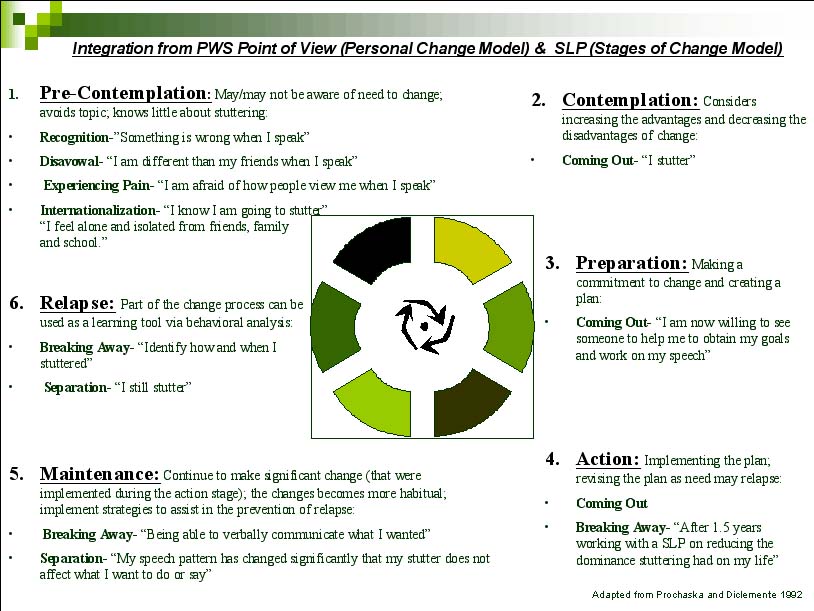Changing the World for People Who Stutter
 |
About the presenter: Michael Sugarman was co-founder of the National Stuttering Project (NSP) in 1977. He became the Executive Director of NSP 1978 -1981 and again in 1995 -1997. Published numerous articles on self help in academic journals and other publications. Recently, named to the Stutterers Hall of Fame. Currently, Chair of International Fluency Association's Suuport |
CHANGING THE WORLD FOR PEOPLE WHO STUTTER
by Michael Sugarman
from California, USA
Not only am I a person who has lived with a stutter, but I am also a trained medical social worker practicing at an AIDS/HIV clinic in California. I have thought a lot about how people move through change and the steps I have personally taken as I have made positive changes in my life. Professionals, researchers, and therapists have also devoted much time and thought to this important topic. I will share my thoughts about how people change, my personal experience with change and how speech therapists can aid in the change process. It is only by working together toward self improvement and awareness that we are able to take the next step -- creating change in our local communities and throughout the world.
Some people who stutter may have had their metamorphosis without intervention or help from a therapist. Others, like me, relied on a combination of speech therapy and peer support to create personal change.
I believe that in order to experience personal change an individual must go through certain steps.
The first one is Recognition: Jerome Bruner, a psychologist helps defines this step. He studied the interactions between mothers and babies. He found that a child's understanding of the world is influenced by interactions with parents or caretakers who verbally label and describe activities and intentions according to their own interpretation. When I was a kid, every time I stuttered, my parents would tell me to "Spit it out!" When I went to talk, I would hear "Stop" in my mind and became very self conscience every time I opened my mouth.
Step Two is Disavowal from a Role: Even though being labeled by your parents is a strong message, I knew that being able to talk and being listened to was important and fought against the way I was seen by my family and others.
The next Step for me was Experiencing Pain: Crichton-Smith studied how stuttering affected people's lives. Her 2002 study indicated that participant's lives were limited in terms of employment and education. The self esteem all fourteen adults who were studied were adversely affected by stammering. In my case classmates in elementary school remarked, "Can't you speak right?" Because I stuttered and had a difficult time expressing myself, they assumed I could not read or think and thought I was a slow learner. In third grade, I was placed in a class for mentally retarded children. Even though I thought others were wrong about me, I was very distraught. I developed two stomach ulcers and overall felt really bad about myself.
Step Number Four: Internalization. Researchers Corcoran and Stewart, in 1998, found adults undertaking therapy identified a common theme of suffering. To me, this was a process whereby I internalized all the negative perceptions around me. I tried to hide my stuttering. I substituted easier words to say.
Step 5: Coming Out. In college, I went through a silent revolt, rejecting the image that I had, by then, internalized - I just could not accept that my life expectations were to be severely limited because of my speech. Coming out is a process whereby one acknowledges and admits to something that is difficult to bring to light. It is a critical step to change. If you don't know what the problem is, it is impossible to deal with. I finally admitted that I stuttered. I admitted that I was limited and afraid and that my life was suffering as a result. I admitted that I did not know how to help myself, by myself. I was ready to let go and seek support and therapy. When I was younger, I had gone to speech therapy, but I was not open or ready for change. Now I was.
Step 6: Breaking Away. In speech therapy I began to unravel my stuttering and self image. I cried. I talked about what was really going on. I was doing poorly in school. I talked about how stuttering affected me. I talked about wanting to have a girlfriend and about my friends. I talked about what I wanted to do with my life. With the support of speech therapy my verbal communication and fluency was improving. I was getting more self confidence and was willing to take more risks. During this phase in my life I became aware of how and when I stuttered. I was able to look at my stuttering from a more objective standpoint rather than simply from a place of fear.
The final step is Separation. I had to remove the self/and society imposed stigma and shame of being a "stutterer" by becoming a "person who stuttered." I told myself "So what if I stutter" "I am OK even though I stutter." Stuttering will not stop me from pursuing my goals." I was asked by the speech clinician to talk with others that stuttered. We met and started a self help group which provides critical support needed to keep making changes in my life. This was 1976 and I was 23 years old. I wanted to start an organization for people who stuttered. Late in 1976 I met Bob Goldman and together we started the -- National Stuttering Project.
Change from Therapist Point of View
Now I would like to examine change from the view of the professional - or speech therapist. A professional's responsibility is to assess the situation of a person who stutters (PWS) and identify areas where change is desirable and possible. Three important questions must be asked:
- What does the PWS want?
- What behavior changes would be beneficial for the PWS in reaching these goals?
- How can a speech professional help the PWS achieve his or her goals?
Change theory from a therapist's view may look different than change from my point of view. After examining a number of change models, there is one that stands out for me and seems the most applicable to stuttering. It may help shed light on how professionals can be change agents and help guide PWS through stages to create lasting change in their lives.
Today, many helping professionals, such as physicians, social workers, psychologists, nurse educators, community organizers and mental health professionals who treat numerous health conditions, use the Stages of Change Model (SCM). The rationale behind SCM is to tailor therapy to a client's needs at his or her particular point in the change process. The SCM shows that for most persons change in behavior occurs gradually through a series of 6 stages.
Stages of Change Model
The first state is Pre-contemplation: At this point, a client may or may not be aware of need to change, avoids topic and knows little about it. PWS is not thinking about change. From the PWS point of view, s/he is probably in one of the first steps of change, still struggling with his/her identity as a PWS and the pain associated with being different. If a client is in this stage it is a very difficult to "move" a client. The SLP may consider building trust to reduce resistance. The SLP seeks to increase the client's perception of risks and problems with current behavior.
The second stage is Contemplation: This happens when the PWS is in the "Coming Out" and "Breaking Away" phases of personal change. The client is able to consider and weigh increasing the advantages and disadvantages of change. PWS sees the benefits and cost of stuttering. The SLP can help by raising a client's awareness by asking "What do you want to be doing/not doing in six weeks or three months? The SLP provides information and reflects back to the PWS his or her desire to change. The professional tips the balance and lays out the reasons to risk change and the consequences of not.
The third stage is Preparation/Determination: A client is making a commitment to change and creating a plan. For example client may be experimenting with small changes -"I asked a question in class". "I asked my boss for time off." The SLP helps the client to determine the best course of action to take in seeking change.
The fourth, Action/Willpower: In this stage the client implements the change plan, revising it as needed. This stage overlaps with "Breaking Away" and "Separation", where the client is able to disclose when and how his stuttering interferes with pursuing goals and fluency. The client is motivated to work on his speech and listen to the treatment plan. The professional provides support and a forum for the client's ambivalence, fears and hopes.
Fifth stage is Maintenance: The client continues to make significant changes. Change in speech becomes more habitual. The professional helps the client take steps to identify and use strategies to prevent relapse. This is an ideal time for the client to participate in a self help group. PWS creates new possibilities of speaking situations or ambitions. The maintenance stage is reached after the behavior has been sustained for six months according to (Prochaska 1994). The SLP uses skills such as problem solving and unconditional support. Discussions between professional and client can include relapse prevention, confidence building and develop workable strategies.
The final stage is Relapse: The SLP teaches the client that relapse is an integral part of change and if he/she experiences a relapse it is more important to continue his or her commitment toward goals and should not be seen as a failure. The PWS thinks "Darn my stutter is returning. I am not going out tonight with other people; because I'll stutter". The SLP helps the client get "back on track" and help the person to maintain their resolve to separate from their identity.
If you look at how these two change models fit together - the first involving personal change and the second being the Stages of Change from a professional's viewpoint, you can see that they overlap. From a client's point of view, the therapist can be the most helpful in helping to create and implement the change plan and giving the client the tools and support necessary to deal with relapse.

Professionals have the unique opportunity to help change not only on a community level but also at the personal level as well -- by providing speech therapy that helps PWS make lasting change and meet their personal goals one person at a time.
References
Bruner, J. "The Mother Tongue" Human Nature, 1978 1. 42 -50 Corcoran, J.A. and Stewart, M. (1998) "Stories of Stuttering: A qualitative analysis of interview narratives" Journal of Fluency Disorder, 23 247 - 264
Crichton-Smith, I. (2002) "Communicating in the Real World: Accounts from People who Stammer" Journal of Fluency Disorder 27 33- 352
Grimley, D., Riley, G., Bellis, J., Prochaska, J. (1993) Assesing the stage of change and decision making for contraceptive use for prevention of pregnancy, sexually transmitted disease, and AIDS. Health Education Quarterly (20) 455 - 470
Prochaska, J. (1991) "Assessing how People Change" Cancer 67 805 -807
Prochaska, J., DiClemente, CC, and Norcross, J. (1992) In search of how People Change", American Psych (47) 1102 - 04
Sugarman, M. (1979) "From Being a Stutterer to Becoming a Person who Stutters" Transactional Analysis Journal Vol. 9, No. 1
Sugarman, M. (1980) "It's OK to Stutter: A Personal Account" Journal of Fluency Disorders, (5) 149 - 157
Zimmerman, G., Oson, C., Bosworth, M. American Family Physician, March 2000
August 10, 2006

